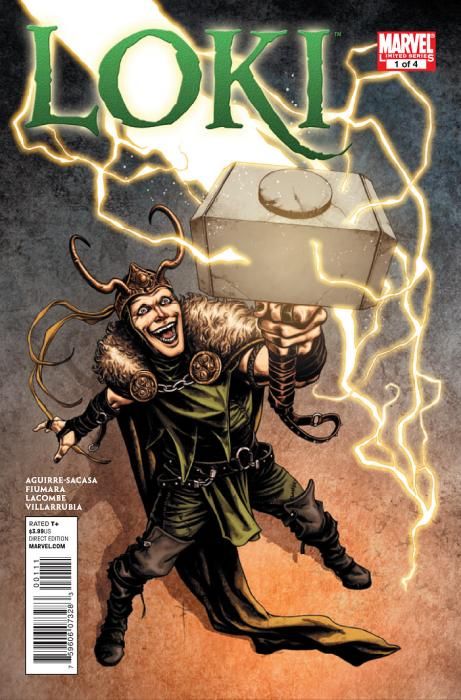The plethora of Thor books adds one where the Thunder God is a supporting character with the focus firmly on his adopted brother, Loki. One of the most interesting Asgardians, at times, Loki has even proved more complex and engrossing a character than Thor. The trickster god is a mess of contradictions, sometimes wanting to do good, sometimes wanting to do bad, often simply compelled to do the wrong thing, unable to be anything other than himself. In the debut issue of this four-issue mini-series focusing on the god of lies, Loki lives up to his name, painting himself the victim, while Roberto Aguirre-Sacasa plays with the idea of myths as malleable stories that shift and change over time with only some success.
Exiled from Asgard, Loki finds himself afraid to make his whereabouts known for fear that his fellow gods will come after him. Those fears are realized quickly. Thor comes after Loki to bring him back to Asgard, but not before Loki tells of how Thor's hammer, Mjolnir, should have been his. As the telling of that story begins, it's hard to know where Aguirre-Sacasa is going, because every version of the creation of Mjolnir follows a similar path: Odin has dwarves create it and gives it to Thor. Here, though, it comes about through Loki's trickery after he plays a prank on Sif out of jealousy of her relationship with Thor. It's not at all the story as we know it.
When Thor comments that that's not how things happened, Loki swears it did. More than that, he doesn't seem to remember anything the way Thor does, with Thor's recollection matching what we've seen in the past. It's an interesting commentary on Loki being such a good liar that he can lie to himself and craft a version of events where he's simply a misunderstood and playful prankster that's been victimized and treated far too harshly. Loki lies even to himself. At the same time, Aguirre-Sacasa tries to comment on the various versions of stories that occur in mythologies, but that point doesn't work entirely. By only presented two versions of what happened, it comes off more as Thor's/our version and Loki's lies. Perhaps future issues will expand upon the point more.
The slickness of Sebastián Fiumara and Michel Lacombe's art matches the slickness of Loki's lies. The art is very superficial, almost too shiny for its own good, much like Loki's story. His version of events paints a much nicer and flattering portrait of himself, much like the art. This is a attractive and 'clean' version of Asgard. That's contrasted with the rougher and darker art that illustrates the framing device of Loki away from Asgard. The line work is bold and allows for bright, vibrant colors from Jose Villarrubia.
Fiumara's art is sometimes too slick and pretty, falling into the trap of becoming static and lifeless. Most of the time, it shows a strong ability to convey emotion as well as use light to heighten the mood of scenes. The style is hard not to love, but the execution sometimes falls short.
"Loki" #1 offers a different perspective on the god of lies, one that may be him succumbing to his own gift for deception. However, there's not enough depth in the issue to truly grab the reader. Both the writing and the art skim along the surface too much, not able to go beyond and truly explore Loki or offer much more than a hint that such an exploration may happen in the remaining three issues.

